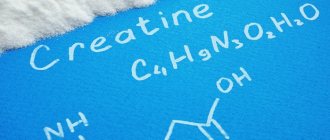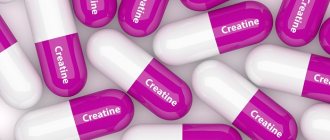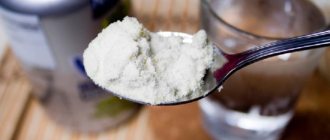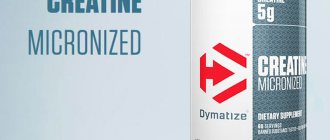© designer491 — depositphotos.com
Share:
Creatine (aminocaboxylic acid) is a source of energy and a compound that has a beneficial effect on the quality of muscles, increasing their strength and endurance. It is believed that the body contains an average of 100-140 g of the substance, 95% of which is contained in the muscles in a free state and in the form of phosphate.
It is synthesized with the participation of glycine, arginine and methionine, forming an amino acid complex. Approximately 2 g are consumed per day with food, mainly with fish and meat. For athletes involved in strength sports (bodybuilding, crossfit and others), this is not enough. Additional dosages in such forms as creatine powder, tablets or capsules increase the effect of training and accelerate the process of weight loss (fat burning).
Optimal dosage regimens
For better absorption, creatine monohydrate or hydrochloride is taken together with other sports supplements - protein-containing shakes, gainers or aminocarboxylic acids - at least 5 g in both options below. You can mix creatine in grape, apple and cherry juice. If there is no sweet juice, you can drink sugar dissolved in water.
No download
Recommended scheme.
- Daily dose – 5-6 g.
- On training days, take creatine after exercise. During the rest period - in the morning.
- The course of admission is 2 months, the duration of the break is 1 month.
This scheme leads to a noticeable increase in muscle mass and strength indicators.
With loading
In the first week, start by consuming 5 g of creatine 4 times a day in between meals (on training days, one serving should be taken after physical activity). After 5 days, the dosage is reduced to 2-3 g, taken once a day after training or in the morning on rest days. The duration of admission and break is 1 month.
Muscle creatine levels remain consistently high even after 12 weeks of maintenance dosing.
If standard doses are not suitable for an athlete (beginners, ectomorphs, teenagers, girls), the individual formula for calculating creatine will be as follows:
- 300 mg/kg – during the loading period;
- 30 mg/kg – during the maintenance period.
How safe is creatine?
Creatine has been studied for a long time regarding its dangers to the body. Most of them prove the drug’s harmlessness even after long periods of use and exceeding the recommended dose. But for a certain category of people there is reason to worry. A byproduct of creatine in muscles is the substance creatinine. It is excreted from the body through the kidneys, but if their function is impaired, this breakdown product can cause exacerbations and provoke kidney dysfunction.
Another important point about the safety of creatine is the quality of the product itself. During the production of sports supplements, contaminants are generated. To date, no studies have been conducted to determine the harmlessness or potential danger of these impurities during long-term creatine use. The most important thing here is to find a reliable manufacturer that offers a high quality product.
Cycling
Consists of 3 stages (dosage is calculated for an athlete weighing 100 kg):
- Take 5 g of creatine in the morning after breakfast, 5 g before and the same amount within 3 hours after training. The remaining 10 g (5+5) are consumed together with a gainer - in the evening or in the morning.
- Do not take aminocarboxylic acid for three days.
Over the course of 8 weeks, 3 days of use alternate with 3 days of abstinence. At the end, it is recommended to take a 7-day break from training (non-training period). During the last 3 days of rest, you need to start taking creatine again.
The cycling scheme aims to ensure high absorption of creatine and achieve its increased concentration in myocytes, eliminating possible disruption of transport mechanisms. But many consider the scheme described above to be erroneous.
Training and creatine
Creatine is a very specific sports supplement. You can get the desired effect from it only if you combine it with properly structured intensive training. As studies show, it is not enough to take the substance and do one-time maximum loads. Creatine can delay the moment of fatigue, so your usual workouts need to be strengthened, otherwise it’s a waste of time and money. It is necessary to do more repetitions to ensure that the muscles in a certain group are already tired and truly worked.
Reception when drying
Whether or not to take creatine during cutting is up to the athlete to decide individually or with a coach.
Let's look at the arguments for and against.
Against
The additive, by promoting water retention in muscle tissue during the drying period, promotes dehydration of the body, which negatively affects the athlete’s well-being.
Behind
Some athletes note an increase in strength and endurance while taking 5 g of creatine along with protein shakes and fat burners.
Release forms
There are two types of supplements on the shelves of sports nutrition stores:
- powder or micronized;
- in capsule form.
There are no differences in how different types of creatine monohydrate work, but each form has pros and cons. Micronized is easier to dose, this is important for a two-phase method of administration. Powder is also often cheaper, which is also an advantage. Capsules are more convenient to take, since you can simply wash them down with water: there is no question about how to properly take creatine monohydrate powder. Those who nevertheless purchased the powder form will have to dissolve it in clean water or juice; other liquids should not be used.
Optimum Nutrition is considered the best manufacturer of creatine, which produces the supplement in both powder and capsule form. Also noteworthy are the products of Maxler, SAN Performance and Ultimate Nutrition.
Optimal doses
No more than 3.5 g of the supplement can be absorbed per day for an athlete weighing 70 kg at a rate of 50 mg/kg. Excess substance is excreted by the kidneys. Therefore, if you weigh 120 kg, it makes no sense to take more than 6 g of the supplement.
It is undesirable to use dietary supplements before bedtime due to the activation of energy processes in the body.
In urine and blood serum, creatine is determined by the kinetic method using a set of DDS reagents.
History of Creatine
The substance “creatine” was discovered by a French scientist back in 1835. It is found most abundantly in red meat, and is also produced by the kidneys, pancreas and kidneys. This substance is found in the human body in two states: free creatine and creatine phosphate. If we talk about the amount of creatine reserves consumed, then the average man needs about 2 grams per day, which are replenished with food and produced by the body. The popularity of this sports supplement among athletes is due to its ability to quickly restore muscle function after intense exercise.
When to take
The best time to take creatine is the first minutes after completing a workout, as physiological changes in metabolism contribute to this maximum. Use during training is not advisable.
Myocytes are forced to expend resources to utilize the substance, which prevents the fulfillment of physical standards. On rest days, the compound is better absorbed in the morning, which is apparently favored by somatotropin, the concentration of which increases in the morning.
Duration of use
From a theoretical point of view, continuous use of creatine is acceptable because there are no side effects. At the same time, there is a possibility that over time, muscle tissue will become less susceptible to this type of sports nutrition. Therefore, courses lasting 45-60 days are recommended, after which you need to take a break.
But it is worth noting that even with a constant annual intake of creatine, the only thing you will have to face is a decrease in its effectiveness.
What to take with
Insulin is a hormone that promotes the absorption of amino acids and glucose by myocytes. It will be useful to stimulate the secretion of this substance by consuming 10-20 g of fast carbohydrates (juice), 20-30 g of fast protein (whey protein isolate) or 5-15 g of amino acids (including glutamine). Somatotropin, thyroxine and anabolic steroids also have an anabolic effect.
Specialized stores sell creatine with ready-made transport systems. At the same time, in order to prevent dehydration caused by the use of creatine-containing dietary supplements, it is recommended to take the dietary supplement with a large volume of water (5 g/250 ml).
It is important to remember that under no circumstances should you mix or use the following supplements at the same time:
- with any hot drinks (high temperature contributes to the destruction of the substance);
- milk (casein impairs the absorption of creatine);
- coffee (the effect of caffeine is similar to casein).
To avoid possible mistakes in using aminocarboxylic acid, it is recommended to carefully study the instructions for use of the dietary supplement.
Side effects
Creatine is natural and has a wide research base. Experiments did not reveal any possible side effects when taking it.
Despite this, all people suffering from chronic diseases such as allergies or asthma should consult their doctor first. Cases of creatine intolerance have not been documented, but may theoretically be possible.
Creatine helps make strength training more effective by speeding up the body's internal processes. Changes will be noticeable after the first course. Strength indicators will improve, muscle volume will increase.
Popular myths
To understand what creatine is and why it is needed in bodybuilding, you should know some reliable facts about this dietary supplement:
- The powder is practically insoluble in water for several days and does not dissolve in the stomach.
- Well absorbed by the body. Its main part is absorbed by muscle tissue without changing shape.
- Creatine prevents water from leaving the body.
- Monohydrate is the most beneficial and effective form.
- There is no scientific evidence regarding negative effects on the body.
We should also add that creatine is useful for weight loss. To achieve the desired effect when using creatine for weight loss, you must strictly adhere to the diet and consumption standards. The drug saturates the body with energy, which allows you to train hard, consuming extra calories. Fat is also lost due to increased testosterone levels. However, in some cases, the supplement may slow down the fat burning process.
Top 10
When choosing a dietary supplement to build muscle mass, how much creatine costs is also important. The rating of creatine with a reasonable price-quality ratio is as follows:
- Dymatize: Creatine Micronized.
- Hardcore Musclebuilding Stack.
- Scitec Nutrition: Creatine 100% Pure.
- Universal Nutrition: Creatine.
- Maxler: 100% Creatine Monohydrate.
- CM2 Alpha.
- SuperPump.
- PureProtein: Creatine.
- BiotechUSA: 100% Creatine Monohydrate.
- NO-XPLODE Creatine.











